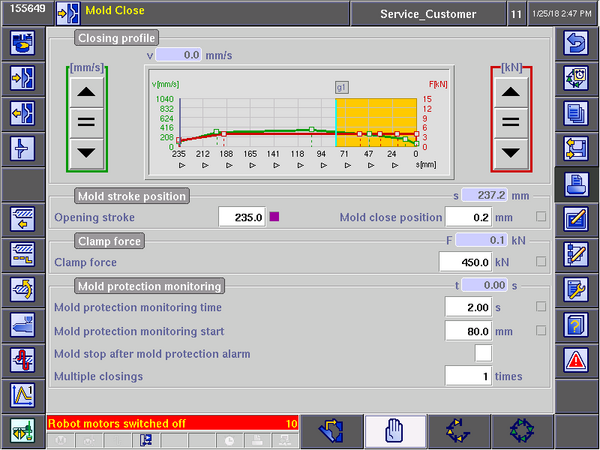Specific Process Knowledge/Back-end processing/Polymer Injection Molder/MoldClose
Jump to navigation
Jump to search
Closing mold
Closing the mold is relatively simple and usually dosn't involve much optimization. There are however a few things to keep in mind when adjusting parameters on the 'Mold Close' screen:
- The closing velocity (green curve) can be set as desired, but avoid running at more than 80% of full speed. It is advised to lower the velocity close to the fully open and fully closed positions (as illustrated in the screenshot). This will help avoid closing procedures where the mold slams violently shut.
- The closing force (red curve) can also be set as desired. A good starting point is to let the green and red curves follow each other. But be aware that the red (closing force) curve should NOT fall off to a very low value towards the fully closed (0 mm) or fully open position. Leave the closing force around 4-5 kN towards the closed position (as illustrated in the figure). If the closing force it set too low at 0 mm, you will get mold protection errors (you're asking the machine to close the mold using a very low force which at some point cannot even overcome the friction of the mold parts when the two halves meet during the final part of closing).
- Avoid setting the 'Opening stroke' to the maximum value, since this can cause the mold to slam against the end stop every time it opens. Keep the opening stroke 3-5 mm below the maximum value (and remember that the robot take-off position will change slightly when you modify the opening stroke).
- The clamp force is usually set to (or close to) the maximum clamping force (450 kN) to ensure the mold is kept tightly closed during injection. In some cases it may be beneficial to lower the clamping force to allow for better degassing during injection. If you experience flashing (polymer escapes the cavity during injection) you should increase clamping force.
- The 'Mold protection monitoring start' distance should be set to the length of the sample. For the samples currently made at DTU Nanolab this is 80 mm.
